The Science Inside 2022
Published 15 November 2022
Introduction by Paul Hollinshead, chief executive of Dstl
We live in times of increasing volatility and uncertainty. The threats we face today both at home and abroad are more complex and dynamic than ever before.
For hundreds of years society has turned to scientists for solutions to the biggest and most fundamental challenges we face. But in this digital and techno-scientific age, science and technology (S&T) is not just the means to overcome individual challenges, it is now an arena of systemic competition in itself, especially in defence and national security.
At the Defence Science and Technology Laboratory (Dstl) we research and apply the rapid advances in science and technology to keep us safe and protect the freedoms and the way of life we expect.
We harness innovation as a force for good. To give the armed forces and security partners an edge over our adversaries, to counter threats and save lives.
We are only able to do this because of the steadfast support and funding for our core science and technology research by the MOD, Home Office and other arms of His Majesty’s Government over many decades.
This investment in our world-class scientists, technologists, engineers, and technicians at Dstl and our UK scientific community in industry and academia advances current and new sovereign capabilities, and has created a powerful skills and knowledge base that is internationally respected.
Sustaining strategic advantage through science and technology is recognised as an integral element of our national security and international policy, fortifying the position of the UK as a global science and technology superpower and responsible cyber power.
These endeavours will be essential in gaining political, security and economic advantages in the coming decade and in shaping international norms in collaboration with allies and partners, while driving prosperity at home.
The Science Inside is a snapshot of projects across UK defence and security demonstrating how the funding and application of scientific and technological advances is keeping us ahead of current and future threats.
Sustained investment in scientific skills and specialised facilities is crucial to unlocking the benefits science can offer, and we hope these insights will help you to see their potential for good and for keeping you and your families safe, now and in the future.
Chief of Defence Staff Visits Dstl - YouTube
Find out about our 22 science and technology capabilities and our research programme.
Advanced lethality
Long range laser trial success
DragonFire Next Generation Laser Dstl - YouTube
The DragonFire laser directed energy weapon (LDEW) demonstrator has successfully completed 2 demanding trials to prove its capability to disrupt enemy sensors and destroy incoming threats.
On Dstl’s test range DragonFire was fired with pinpoint accuracy over a distance of 3.5km in the UK’s first high-powered, long range laser trial. Designed to operate over even longer ranges DragonFire was deployed against representative targets including static sheets of metals and other materials of varying thicknesses, and mobile targets such as small uncrewed aerial vehicles (UAVs).
The firing followed an active tracking accuracy trial at the QinetiQ Aberporth range. In difficult weather conditions due to Atlantic storms the system performed to its requirements and demonstrated the tracking accuracy necessary to maintain a constant lock on surface and air targets. The future aspiration for the system is to conduct an above the horizon trial in the UK in 2023 and 2024 against instrumented surface and air targets to fully test system performance against a demanding target set.
The UK DragonFire consortium, contracted by Dstl, is led by MBDA and comprises Leonardo, QinetiQ, Arke, BAE Systems, Marshall and GKN. This new UK sovereign capability is designed to provide short-range air defence and close-in protection for naval vessels using a range of different effects depending on the tactical scenario. These include identifying, tracking and deterring a potential threat by dazzling its targeting sensors, as well as damaging or even destroying the incoming threat.
Informing and analysing lethality options
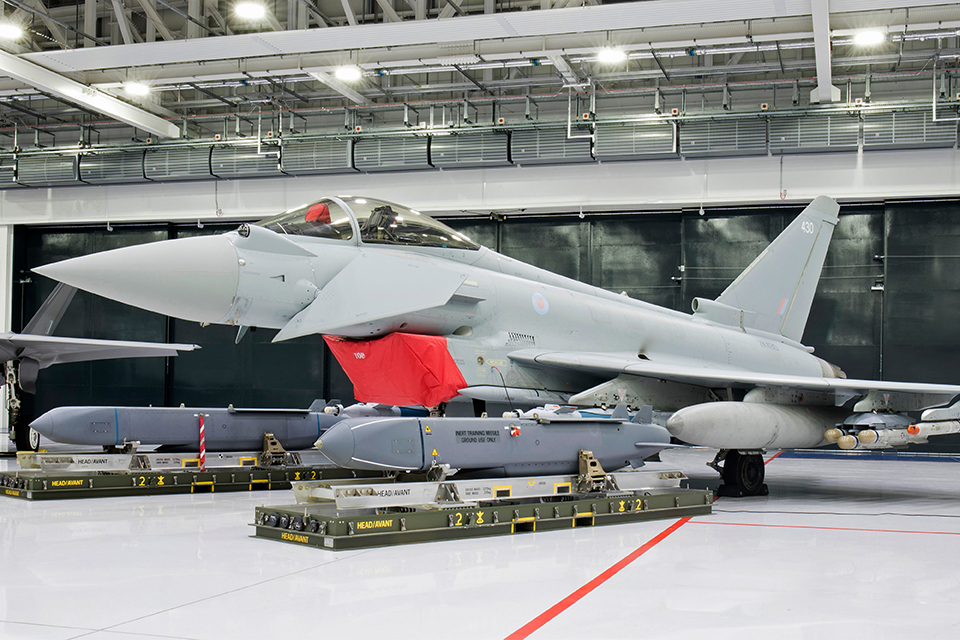
Storm shadow missiles next to a Typhoon fighter jet
Dstl’s high quality advice is contributing to the Future Cruise/Anti-Ship Weapon (FC/ASW) Acquisition Programme to procure a weapon system to replace both the Storm Shadow deep-strike missile and the Harpoon anti-ship missile.
Dstl delivered defence scenario-based operational analysis through detailed assessment of the operational effectiveness of candidate weapons, and rigorous justification of the military need and requirements.
The analysis team coordinated a cross-disciplinary effort covering lethality, survivability, navigation and target acquisition, integrating knowledge from across Dstl and working closely with Defence Equipment and Support (DE&S) and MBDA.
Hypersonic concepts take shape
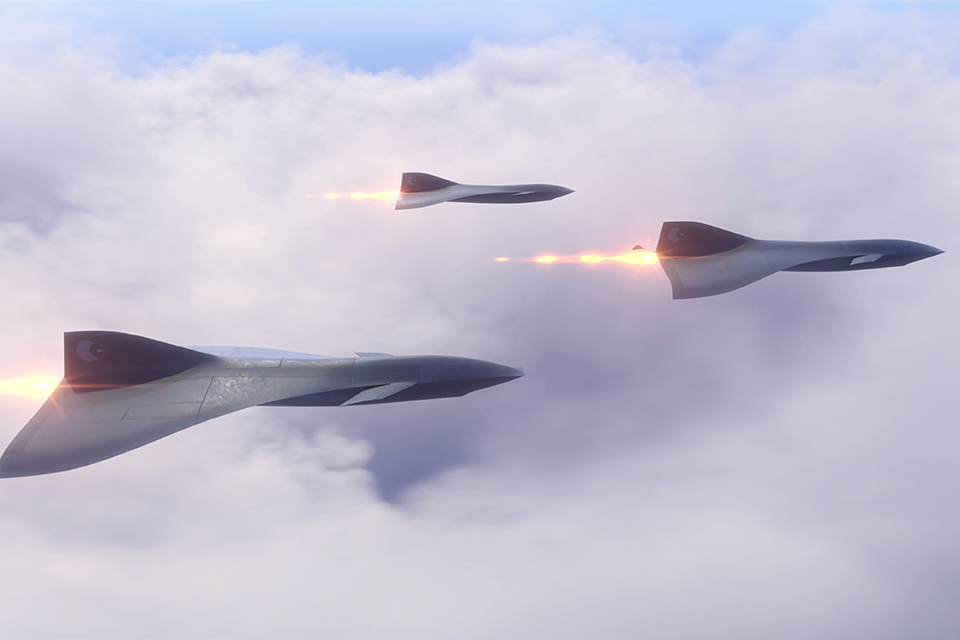
Artistic impression of hypersonic air vehicles
Dstl’s hypersonic weapons programme was established in 2022 to deliver a hypersonic cruise missile technology demonstrator by the middle of the decade and invest in broader generation after next hypersonic weapon concepts and technologies. This will provide a transformational capability that delivers operational advantage for the future UK armed forces.
Separately Dstl is working with Reaction Engines, Rolls-Royce, the Royal Air Force’s Rapid Capabilities Office (RCO) and the UK’s National Security Strategic Investment Fund (NSSIF) to deliver the Hypersonic Air Vehicle Experimental (HVX) Programme to establish the UK as a leader in reusable hypersonic air systems.
The team will rapidly develop critical high-Mach/ hypersonic technologies, including novel air-breathing propulsion architectures, innovative thermal management systems and advanced vehicle concepts.
HVX’s immediate objective is to rapidly mature technologies which can deliver a step-change reduction in the cost of developing a reusable high-Mach/ hypersonic air vehicle. Design work is underway on experimental hypersonic vehicle concepts such as a single engine variant, ‘Concept V.’
Multi-domain integration
Multi-domain integration (MDI) is the ability to sense, understand and orchestrate across all 5 operational domains, in concert with other instruments of national power, allies and partners, to deliver a desired outcome. MDI is a complex ecosystem.
Operational success will be realised by harnessing this complexity, exploiting the wealth of information at our fingertips, developing and using new information age effectors and effects synchronisation, ensuring any combination works together.
It is critical that defence’s systems across all land, maritime, air, cyber and space domains can work together seamlessly. Science and technology can help navigate this complexity, creating an MDI-optimised future while maximising the utility of our legacy systems.
Conflict is unpredictable, and commanders need ready access to a suite of military capabilities that will work seamlessly together when needed. Science and technology is helping commanders exploit the sub-threshold zone by shaping adversary thinking through information effects, by developing cyber and electromagnetic effects that are synchronised and deconflicted with other activities in the increasingly congested electromagnetic spectrum, to exploiting space as a new domain of operation.
Many of the critical technologies needed to achieve the MDI vision are invisible. Resilient integrated command, control, communications and computing are essential, as is being able to sense and understand what is happening. Curating and sharing data across multiple systems, domains and organisations is a key technical challenge for science and technology .
This is compounded by the need to navigate multiple classifications, and ensuring this is conducted at the right operational tempo - the right information, at the right place, at the right time.
Defence holds a lot of valuable data, but it needs to be fused and harnessed rapidly to produce decision-quality information - our defence led science and technology is working with a broad range of suppliers to bring to bear the best minds on our most challenging problems.
But MDI is broader than defence; we are working across government and allies too. Collaboration and innovation are key to helping defence realise the MDI vision.
Collaboration in science and technology is fundamental to the difference we make, as are game-changing advances and innovation wherever they can be found - only by bringing together the best minds will we meet the challenges of operating and winning in the future battlespace.
Integration is the only way ahead - how we can achieve this, overcome the barriers and drive it into our thinking and culture needs to be at the forefront of our minds whether we are working on a science and technology project or operating in a front line role… MDI is a team sport.
Autonomous sensors reduce operator burden
Contested Urban Environment experiment
The multi-national Contested Urban Environment (CUE) experiment in Portsmouth illustrated the benefits of Dstl’s SAPIENT autonomous sensor system.
In the Sensing for Asset Protection with Integrated Electronic Networked Technology (SAPIENT) system, the individual sensors are advanced, using artificial intelligence (AI) to make detections and classifications locally, sending only the information not the raw data, to a decision-making module for command and control.
They also make operating decisions autonomously, such as which direction to look or whether to zoom in, to fulfil higher-level objectives. These are managed by the decision-making module which controls the overall system and makes some of the decisions normally made by the operators.
This reduces the operator’s need to constantly monitor the output of the sensors. CUE was the largest application of SAPIENT involving multiple sensors, locations and nations. Around 60 different technologies were trialled including radars, LiDARs, CCTV cameras and uncrewed ground vehicles (UGVs) across the land, maritime and air domains.
SAPIENT has also been adopted by MOD as the standard for counter-uncrewed air systems (C-UAS) technology and was evaluated at the NATO technical interoperability exercise (TIE22) in The Netherlands. This enabled 31 advanced autonomous sensor modules from different vendors to connect to 13 decision-making modules.
Reducing network boundaries
Data Centric Security (DCS) is one of the key enablers to realising the multi-domain integration’s objective of a single information environment; reducing network boundaries and unlocking data silos.
Using a UK DCS architecture, Dstl demonstrated the first and only federation of 2 coalition DCS Systems (UK and US CENTCOM), enabling direct transfer of editable and shareable data objects between the 2 national systems, significantly enhancing information interoperability and data sharing.
Space
Defence satellites aboard first UK launch
Over the next 4 years defence will launch up to 8 satellite demonstrator missions, supported by Dstl’s space systems programme.
The first 2 of these will be launched from the UK on Virgin Orbit’s dedicated small satellite launch service, which has been facilitated by the US National Reconnaissance Office and is due to take off from Spaceport Cornwall.
One of the missions is known as Prometheus 2, and will operate 2 cube-satellites in Low Earth Orbit, around 550km above the Earth and 50 to 100km apart.
Co-funded with Airbus Defence and Space who are designing them jointly with In-Space Missions where they are built, the 2 tiny satellites are comparable to the size of a cereal box. They will provide a test platform for sophisticated imaging, and monitoring radio signals including GPS, paving the way for a more collaborative and connected space communication system with our combat allies.
The UK launch will also carry the CIRCE (Coordinated Ionospheric Reconstruction Cubesat Experiment) mission being conducted by Dstl in collaboration with the US Naval Research Laboratory. CIRCE will monitor environmental changes in the Earth’s ionosphere. Data will be captured by a UK miniaturised space weather sensing suite designed in collaboration with academic partners University College London’s Mullard Space Science Laboratory, the University of Bath, and Surrey Satellite Technology Limited, drawing on expertise from the University of Surrey.
Minerva satellite constellation
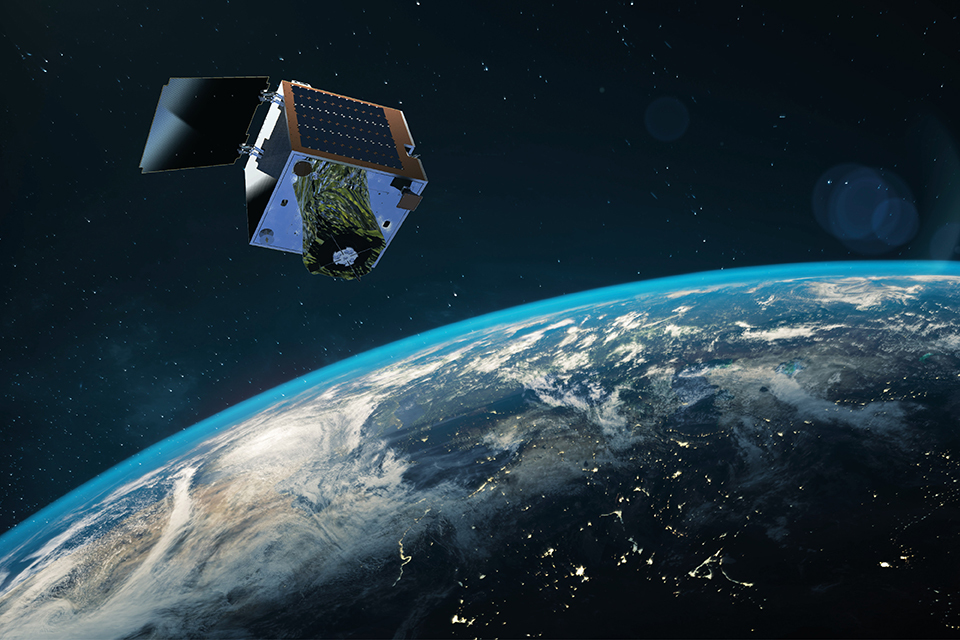
A satellite orbiting the world
Dstl is supporting MINERVA, a £127 million investment over 4 years to develop a network of space platforms and ground systems, designed to integrate space with other domains.
An operational concept demonstrator, MINERVA will show the UK’s ability to autonomously collect, process and disseminate data from UK and allied space assets, to better aid frontline military decision-making on the ground.
MINERVA will launch 3 satellite missions that will provide test platforms for Dstl to conduct various experimentation activities to inform future capability decisions:
- Satellite MINERVA 1A (TYCHE) will have an electro-optical (EO) sensor
- MINERVA 1B (JOVE) will be a cluster of satellites with EO and passive radio-frequency (RF) sensors and inter-satellite links to begin a multi-sensor approach
- Satellite MINERVA 2 (JUNO) will have an EO sensor and will operate in conjunction with a US-developed satellite architecture to begin international partner integration
The developed and tested system will be brought together by UK Space Command through the ISTARI intelligence, surveillance and reconnaissance (ISR) satellite programme.
Work delivering the concept demonstrator systems is already underway. The JOVE mission team is evaluating 3 preliminary designs from UK industry to select a supplier.
Dstl has been working closely with DE&S, putting together jointly the competition document for the upcoming JUNO mission, as well as supporting wider UK Space Command ISR programmes.
Hyperspectral space study
Dstl has worked with both Thales Alenia Space (TAS) and Airbus Defence and Space (ADS) to develop solutions for SYCORAX, a space-based hyperspectral imaging system concept that could provide a unique future intelligence-gathering capability using a wide range of wavelengths of light, including those beyond the visible.
Each concept has developed individual innovative solutions to make this possible: a ‘skimsat’ using electric propulsion in Very Low Earth Orbit (TAS) and an innovative spectrometer to improve signal-to noise ratio (ADS). This technology is one of several being considered for exploitation within MOD’s future space-based ISR programme, ISTARI.
Revolutionary optical communications satellite
The TITANIA satellite is due to launch in 2023 and will be capable of high-speed data transmissions from space via its optical link.
Being built by In-Space Missions, TITANIA aims to develop the science, and demonstrate the military utility, of Low Earth Orbit (LEO) direct-to-Earth Free-Space Optical Communications (FSOC). This supports the concept of information advantage, by providing the ability to increase the rate at which data can be transferred from space, whilst also increasing resilience and protecting data in RF contested and congested environments.
Cyber and information systems
Cyber protection for carrier strike group
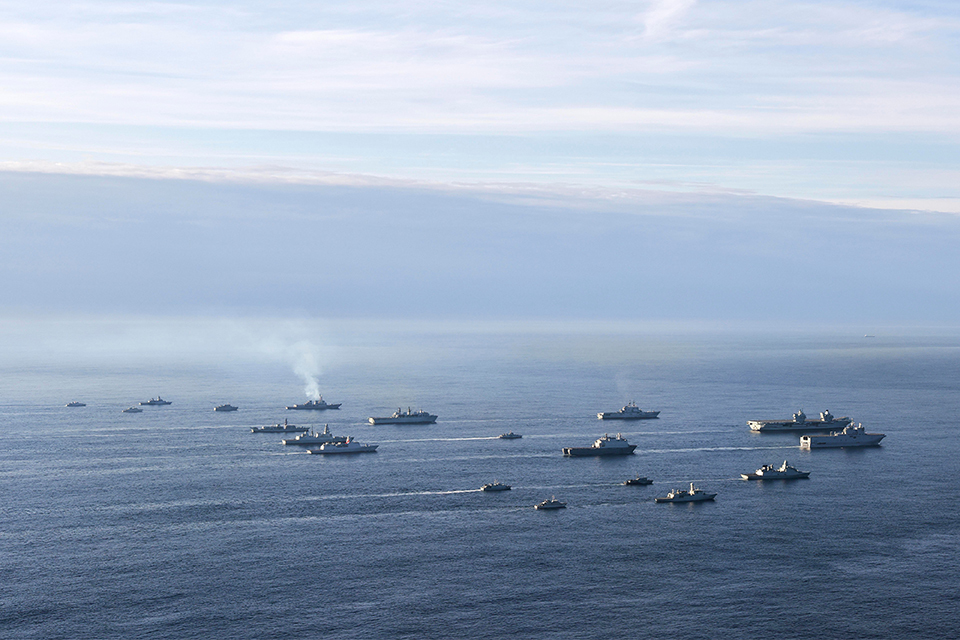
A dozen warships part of a carrier strike group
Working with the Royal Navy (RN) and industry partners, Dstl is conducting multiple activities to better understand and mitigate the cyber risk to the Carrier Strike Group (CSG).
This includes the first instance of using engineering data to detect potential cyber activity on a platform to achieve a proof of principle demonstration of end to end capability.
Our human behavioural scientists supported a simulated cyber incident live at sea on an active RN vessel and helped assess the levels of response required.
Dstl delivers evidence-based resilient sensing, information and effector systems. We advance the tools, techniques and tradecrafts required to establish world-class capabilities to detect and counter threats to UK defence and security.
Maintaining access in contested electromagnetic environments

A soldier witnessing an explosion
Dstl has provided concepts which allow defence to exploit the electromagnetic environment (EME) for integrated survivability against conventional threats.
The future EME will be increasingly contested, degraded and operationally limited. The UK armed forces have a requirement to maintain freedom of access and manoeuvre (FOAM) in this environment.
This science and technology research has identified next generation countermeasures concepts and technologies to improve integrated survivability against conventional threats. Some of the identified next generation technologies/concepts have already been transferred for further development and onward exploitation.
The next generation UK military capability conceived to ensure defined routes and areas can be cleared of emplaced explosive ordnance is named ‘Ground Area Reconnaissance and Assurance’ (GARA).
Its primary functions are to detect, mark and/or neutralise emplaced ordnance at a safe distance in order to render an identified route safe and intact for military vehicles and personnel to transit.
Dstl research has supported GARA development by identifying and developing exploitable concepts to neutralise ‘tactically-emplaced explosive devices’ by electromagnetic means at sufficient distance from protected elements, and restore freedom of action in defence and security operations.
It consists of a collection of low technology readiness level (TRL) concepts for both neutralisation by inhibition, dudding and pre-detonation and also concepts that support or enable neutralisation, such as autonomous decision-making for neutralise and simultaneous transmit and receive (STAR).
Quantum
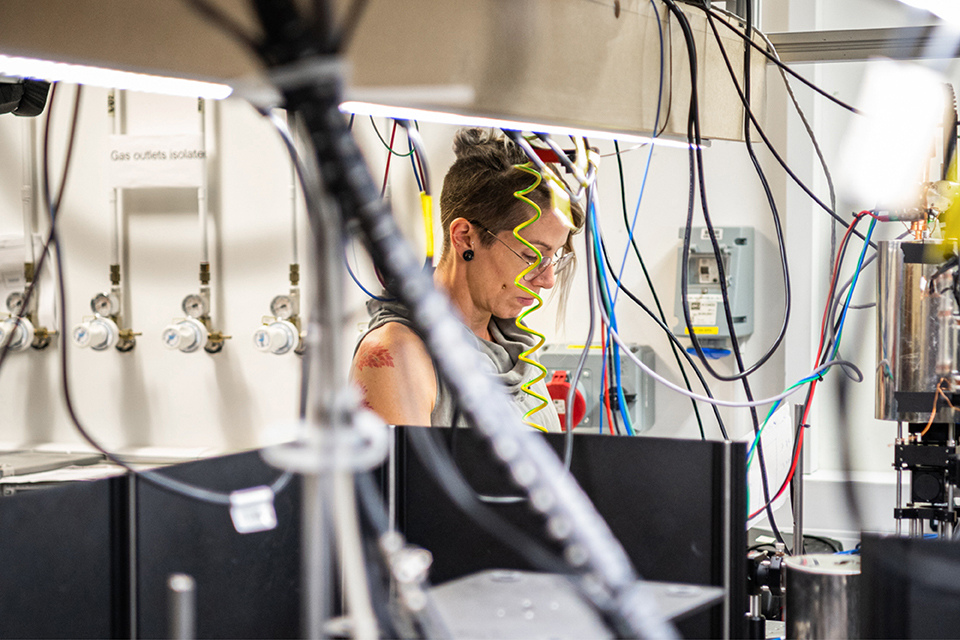
A scientist in a quantum laboratory
Revolutionary technologies such as semiconductors, lasers, nuclear power and magnetic resonance imaging owe their existence to the breakthroughs in understanding quantum phenomena.
The last half a century has seen remarkable progress in the fields of atomic, molecular and optical physics, as well as laser design, material science, and computer modelling, which together allow us to tame and manipulate quantum phenomena to our advantage.
This is the so-called ‘Quantum 2.0’ revolution.
Quantum provides increased sensitivity as we are measuring the response of single atoms; better accuracy as quantum technology is used to define measurements; longer stability because atomic species do not wear out and are identical; and reduced noise via correlations (entanglement).
Four main areas of application are clear: computing, communication, sensors (including timing), and imaging. Dstl has been closely involved with the National Quantum Technology Programme since its launch in 2014, primarily focusing on sensing and timing, but now expanding to include quantum information-processing and potential advantages in optimising machine learning via analogue quantum processor units (QPUs).
We recently purchased a quantum computer from ORCA, which will be based in the National Quantum Computing Centre. ORCA’s PT-1 model is the first computer of its kind to operate at room temperature and be based on-premises.
ORCA computing has developed hardware and software that allows small-scale photonic processors, which use single units of light, or ‘photons’, to be applied to complex machine learning and optimisation tasks.
These include image analysis, handwriting recognition and decision-making.
We are still forging ahead in the other fields and the engineering challenges to bring them out of the laboratory:
- exploring future atomic clocks and inertial sensors to protect defence and critical national infrastructures from the potential loss of GPS
- building extremely wide spectral bandwidth RF sensors using atoms as antennae
- using single photon ranging to see through foliage and clutter
- developing gravity sensors to passively navigate anywhere in the world
- using entangled photons to ‘see’ in wavelengths no camera technology can operate in
- matchbox size magnetometers that use vapour of atoms to monitor brainwaves
These systems do not act alone and require precision ‘classical’ technologies to operate, which is what makes them challenging to move out of the laboratory. However, we will see quantum-enhanced technologies having a profound impact on defence and security over the next decades.
Watch this (quantized) space!
Generation after next
Generation after next is capability that currently does not exist and where contributing technology is not fully understood. Concepts will be ‘leap ahead’ and world-leading to challenge the boundaries of current and emerging understanding.
While there are many urgent technological and scientific problems we need to address, by lifting our eyes to the long-term we can actively shape the future and move ahead of our adversaries.
Turning DNA into green power
Bio-Batteries: The Power of DNA - YouTube
A novel DNA application could provide a safer, greener solution to generating power with potential uses across society.
Current battery technology used by the armed forces contains a lot of energy in chemical format and if that battery gets shot it might explode and burst into flames.
The bio-battery is made out of DNA, enzymes, lactate and water so will not harm the wearer if it is damaged.
The idea is scalable and could take the form of large batteries, batteries too small to see or a completely new format such as a coating.
The pioneering collaborative project is being undertaken by scientists at Touchlight Genetics and University of Utah, funded by MOD and the Office of Naval Research Global (ONRG).
Saving lives with bioengineered blood
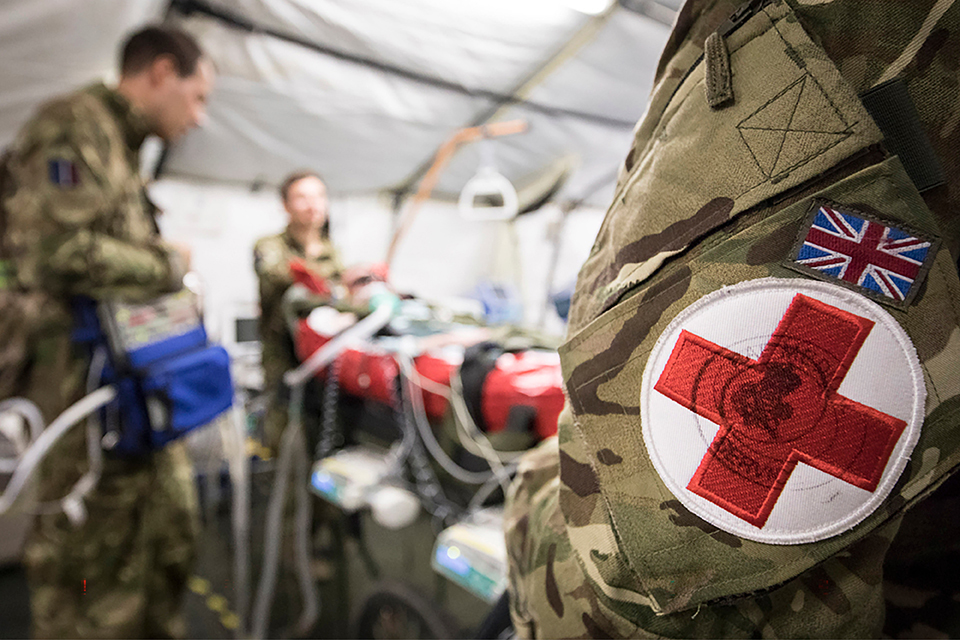
A military medical room with a patient on a bed
One in 3 combat casualties injured during the Afghanistan conflict required a blood transfusion. Defence funding is supporting the development of bioengineered lab-grown blood that would reduce the need for human donation and optimise the properties for Defence Medical requirements.
Dstl is working with experts from the National Institute for Health and Care Research Blood and Transplant Research Unit at the University of Bristol, who have used genetic engineering to produce a cell line that makes blood cells of a universal type.
They are investigating other genetic changes that would enable the blood cells to be stored longer and be easier to use on combat operations. The research is assessing the potential of freeze-drying and removing the need for refrigeration.
Bacterial study aims to boost deployment
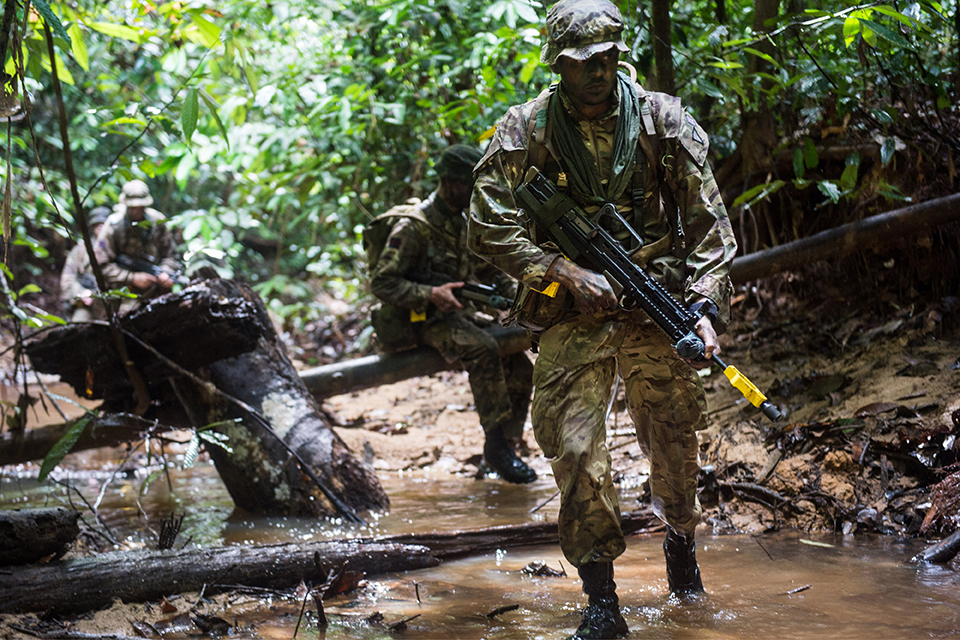
Soldiers in the jungle
Dstl researchers have been working collaboratively with the University of Birmingham to explore differences in gut microbiome between different populations in the British Army.
During deployment overseas, operational effectiveness is frequently impaired by the onset of travellers’ diarrhoea (TD) amongst soldiers, which appeared to be more common in soldiers of British origin than soldiers of Nepalese descent (such as Gurkhas).
A hypothesis was developed that this difference could be due to differing gut bacteria between the 2 populations. To test this hypothesis, MOD-funded research was undertaken to understand the gut bacteria of soldiers from both groups when resident in the UK, which has shown there is a difference between the groups.
If this variation is also present during overseas deployment, this could explain the difference in TD rates between the different populations. Further work is ongoing with the aim of intervention to prevent diarrhoea during deployment, therefore increasing operational effectiveness and advantage.
Artificial intelligence
AI: Changing the Battlefield We need your help Working with Dstl - YouTube
Each and every day, our sailors, soldiers and aviators protect our country, willingly putting themselves in harm’s way in order to keep us all safe. In the most challenging of environments - hot, cold, disconnected, disrupted, confusing and rapidly changing - they are making life-or-death decisions in some of the most complex situations you could imagine.
AI has the potential to provide radical technical enhancements and Dstl’s work is ensuring we can successfully adopt this powerful technology safely and responsibly across defence and security.
Machine scale analysis
Analysis of intelligence is human centric. It is therefore constrained by the number of analysts we can train and their ability to find the ‘needle’ in a vast ‘haystack’ of data.
What if intelligence analysis was only constrained by the available data, algorithms and computational power available? Dstl’s work is demonstrating how AI might free human analysts to spend more of their time making sense of information and putting it into context.
Machine speed analysis
We need to outpace our adversaries, with faster and better decision making in every environment, domain and level of command. What if we could use AI to help commanders better understand the evolving situation and their options? Dstl is working with international partners to show how human-machine teams can support our people and help them continually adapt and rapidly respond to challenging operational requirements.
Fighting the information war
Modern warfare is accompanied by a wave of misinformation; AI could turn that into a tsunami. Deepfake videos, imagery, audio or text - will we be able to believe what we see in the future? Dstl is developing technologies that can better understand audiences, help provide verifiable and trusted narratives, and counteract fake news by detecting and defeating conventional and algorithmically generated misinformation in real time.
Increasing everyone’s impact
How do we increase an individual’s impact by enabling each human operator to safely control multiple autonomous platforms? Dstl’s research is demonstrating how AI agents can enable each human to achieve more. A single pilot, soldier or sailor could have an even greater ability to counteract threats and protect civilians.
Safely and responsibly harnessing AI to support our armed forces is a critical challenge for our generation. If you are an AI-start-up, an academic, a tech company, an exporter, a not for profit organisation, or an established defence contractor looking to the future, we may well be able to put your talents to work.
Our armed forces deserve the best that science and technology can offer to support them in their difficult jobs; we need the brightest minds to help solve these important challenges.
AI expansion nationwide
Dstl Newcastle Advancing AI - YouTube
In support of MOD’s AI Strategy Dstl has formed the Defence Data Research Centre (DDRC) as part of the newly-established Defence AI Centre. The DDRC comprises a consortium led by the University of Exeter, supported by the Universities of Liverpool and Surrey and the Digital Catapult.
The centre will focus on problems related to the use of data for AI applications, which can often be inaccessible or unusable in its raw state. The principal task will be investigating problems within a defence context, such as logistics support, object tracking and data wrangling among many other potential areas, with the expectation that any solutions and mitigations developed by the centre could be applied elsewhere to benefit the wider UK economy.
In conjunction with the Alan Turing Institute Dstl has also launched the AI Research Centre for Defence Research (ARC-D) to resolve the underpinning problems associated with enabling advances in AI capability. Examples include areas such as:
- low short learning - the ability to train machines to learn without the need for vast amounts of data
- crypto-ML - applying machine learning to encrypted data
- the application of AI to wargaming
- understanding the limits of AI models
- managing multiple sensors
- human-centric AI
- ethics
The centres continue the geographical expansion of Dstl’s AI capability, following the opening of Dstl’s Newcastle hub to provide greater resilience, capacity and diversity in AI and data science by accessing regional expertise.
Support to operations
Ukraine
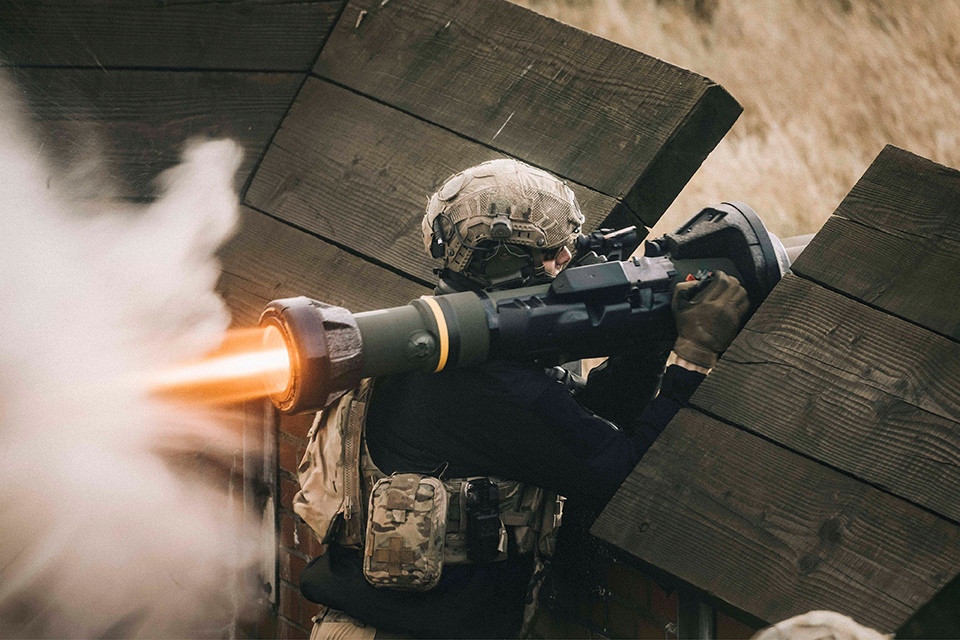
An anti-tank weapon in use, resting on a soldier's shoulder
The UK and our international partners are united in support for Ukraine. The UK government is providing a range of economic, humanitarian and defensive military assistance to Ukraine, and is imposing additional sanctions on Russia and Belarus.
Along with partner nations the UK will provide long-term military funding, ensuring a steady flow of finance to provide vital military equipment, essential maintenance of existing kit and maximising the UK-led international training programme for Ukraine’s armed forces.
The UK is at the forefront of providing vital military assistance to Ukraine. Since the outbreak of war the value of total UK military support is £2.3 billion - more than any country other than the United States. Support so far includes more than 5,000 NLAW (next-generation light anti-tank weapon) missiles made in Northern Ireland, long-range multiple launch rocket systems, artillery systems, including 155mm self-propelled guns, and rapid design and production of short to medium range persistent loitering munitions by a UK start-up company.
Dstl was instrumental in the development, trialling and assessment of NLAW, and its ability to engage moving targets, overfly and discriminate between potential targets, resulting in its proven ability to defeat modern Main Battle Tanks in Ukraine.
This work was only made possible because of more than 20 years of expertise built within Dstl by MOD science and technology funding through the Chief Scientific Adviser’s research programme. Dstl is integral to the UK’s response to Russia’s illegal invasion with contributions across 22 separate science and technology capabilities
We have provided ongoing operational support and advice to customers such as the Permanent Joint Headquarters since the start of the conflict covering a multitude of areas.
Dstl is able to deliver novel solutions to urgent challenges and crises because of MOD’s enduring science and technology investment in research, key capabilities and facilities, allowing it to provide an indispensable source of rapid and diverse technical support. We will continue to provide support to the UK response to the invasion of Ukraine.
Maritime
MAPLE influences Royal Navy’s digital strategy
Future Naval Technology On Display Rear Admiral James Parkin visits Dstl’s Portsdown West - YouTube
A common framework for the command and control of uncrewed vehicles, individually and in swarms, has been developed by Dstl.
Maritime Autonomous Platform Exploitation (MAPLE) enables integration into a ship’s combat management system, maximising data utility and minimising the operational impact on human operators.
MAPLE has been exploited by the Royal Navy, including Navy X, the Navy’s autonomy and lethality accelerator, through operational experimentation and has been at the centre of international collaboration with allied partners seeking to maximise interoperability and interchangeability of surface, underwater vessels and aerial vehicles.
The work was developed with industry partners over 8 years and has influenced the Navy’s strategy for providing a digital backbone through the Naval Strike Network programme, and to date, specific applications have been trialled in harbour protection and anti-ship missile defence using recoverable decoys.
MAST targets longer duration

A small autonomous boat on the waves
Dstl’s Maritime Autonomy Surface Testbed (MAST) vessels have guided the Royal Navy’s understanding of the capabilities of autonomous systems and underpinned the development of the RN’s innovation unit NavyX.
Having demonstrated proof of concept, future work will focus on understanding the issues associated with operating uncrewed surface vehicle (USV) systems beyond line-of-sight and for longer durations. Scientists across multiple Dstl programmes such as maritime, robotics and autonomous systems, and future sensing, will collaborate to further explore the integration of multiple crewed and uncrewed systems in swarms.
The MAST vessels will continue to provide a platform to trial technologies, such as sensors, payloads, effectors and software, from industry and new concepts of operation, supporting NavyX’s operational experimentation.
Type 31 analysis stretches overseas
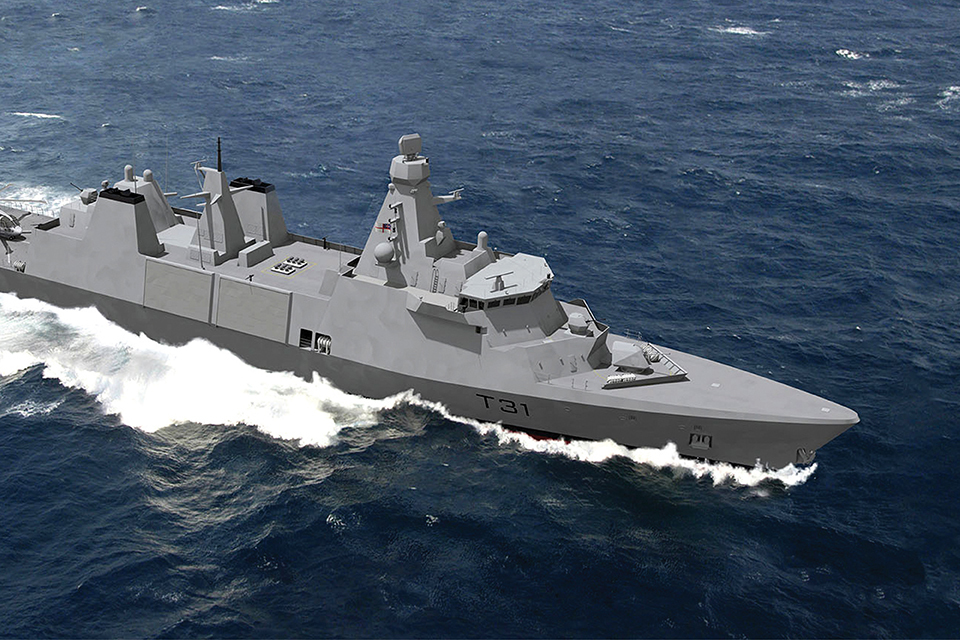
An artist impression of a Type 31 frigate [Copyright Babcock International]
Our analysts proved that 5 Type 31 frigates could do the work of 11 with overseas basing at strategic locations around the world removing the need to return to the UK for crew handover, saving around £10 billion in procurement costs.
Dstl’s work also helped reduce the time from concept to service, enabling Type 31 to be delivered in as little as 7 years compared to the 20 plus years for previous frigates. Crewing has reduced by 30 to 40%, from around 170 to 105 per ship.
The Type 31 has already been successful on export markets - with orders for UK industry partners from Indonesia and Poland. Dstl also provided the threat and evidence base for the Navy’s Type 32 frigate, the first of a new generation of warships with a focus on hosting and operating autonomous onboard systems.
Supporting the deterrent
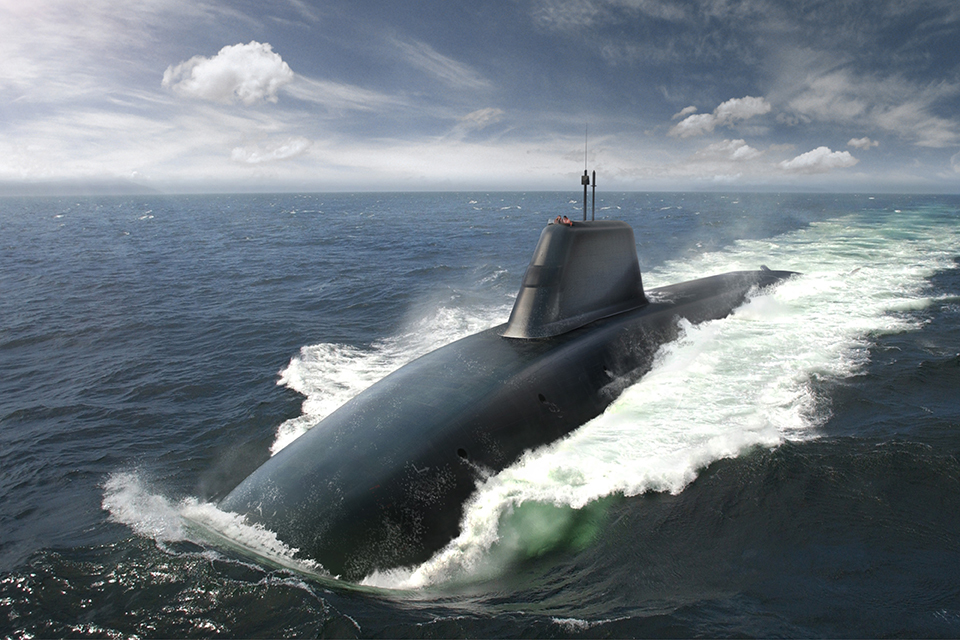
An artist impression of a dreadnaught submarine [Copyright BAE Systems PLC]
Since April 1969, there has always been a Royal Navy ballistic missile submarine at sea. Armed with strategic nuclear missiles, these submarines have acted as the nation’s continuous nuclear deterrent, sending a clear message to would-be aggressors.
Dstl, through MOD science and technology funding, has been instrumental in supporting the Continuous at Sea Deterrent through numerous means such as materials testing and evaluation, threat evolution analysis, sustaining the capability of specialist personnel and annual table top exercises, working with the RN, Defence Nuclear Organisation, and Submarine Delivery Agency to maintain the credibility and capability of the fleet.
A new class of ballistic submarine, the Dreadnought class, is currently under construction, supported by Dstl, and is expected to replace the Vanguard-class by the 2030s, ushering in a new era of at-sea deterrence.
Autonomous harbour protection
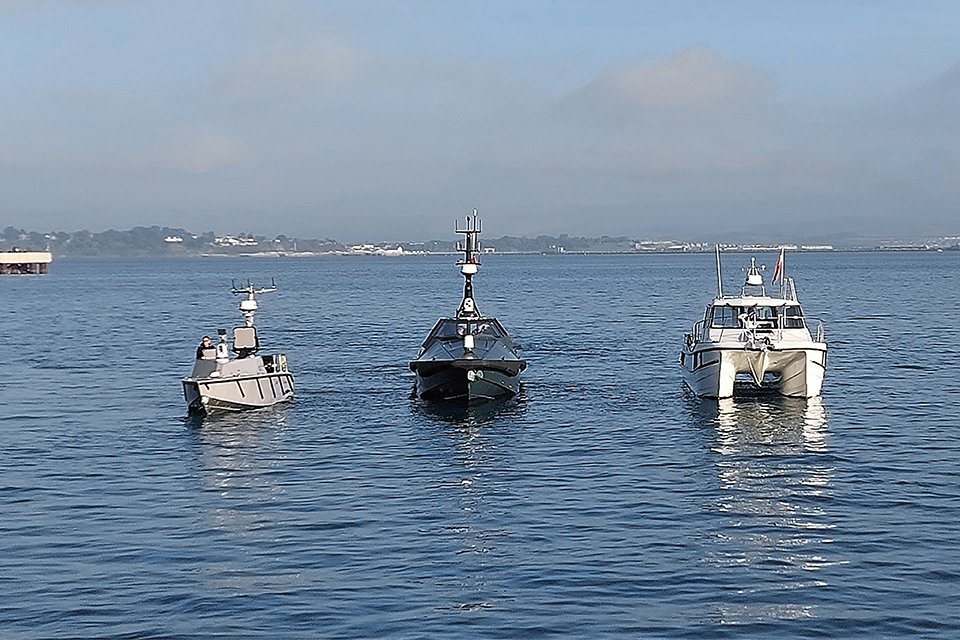
A small autonomous vessel on harbour patrol
Autonomous MAST vessels were deployed alongside shore-based surveillance systems to assess their benefits to harbour protection missions, in a 3-year joint UK-US project.
The work culminated in a trial in Portland Harbour which showed the benefit that USVs and UAVs could play in enhancing the surveillance picture and providing a rapid interdiction capability against surface and underwater suspect contacts. This work adopted synthetic-based testing and autonomous system algorithms before deploying in a controlled exercise.
Dstl The People Inside - Alasdair Gilchrist - YouTube
Land
Bolstering Army striking power
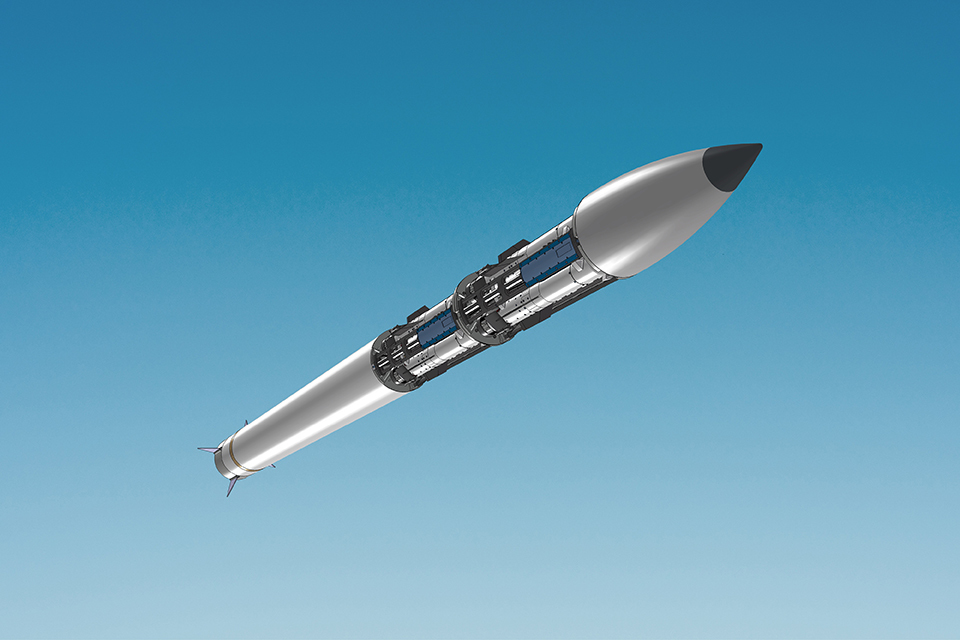
An artistic impression of an advanced missile
A key element of the Army’s modernisation for the 2020s and beyond will be achieved with Dstl research into advance missile technologies to form future weapons systems.
The systems will increase the combat effectiveness of Brigade forces to outrange and overmatch targets and long range Divisional deep effects to restrict adversaries’ freedom of operation and manoeuvre.
Dstl’s research and development include:
Battlegroup Organic Anti-Armour programme
The importance of effective anti-tank capabilities has been demonstrated in Russia’s invasion of Ukraine, from man-portable, shoulder-fired missiles to platform-mounted multiple missiles. Four future anti-tank capabilities will include: smaller, wider spectrum, low-cost sensors; non-line of sight capabilities; and third-party control of targeting and firing to increase the accuracy and range of engagement
Advanced Modular Missile Station
Dstl is working with Army HQ and DE&S to develop a technology demonstrator to detect and destroy multiple armoured and air threats at ranges in excess of 8km. This will allow the Army to adapt and enhance capabilities rapidly to meet the geopolitical and geoeconomic shifts.
Deep Fires Rocket Systems
A single platform with multiple effectors, capable of independent precision targeting of threats out to 150km. Dstl is working with industry to develop a missile to engage high value, time sensitive moving targets (land precision strike) and a dispensing rocket payload that provides target acquisition, kinetic and non-kinetic effect against multiple dispersed targets (long range area effect).
Close Support Artillery
Dstl is developing a revolutionary new light gun replacement with industry, challenging current commercially available systems to deliver a capability to meet the needs of expeditionary forces.
Bubble shield for armoured vehicles
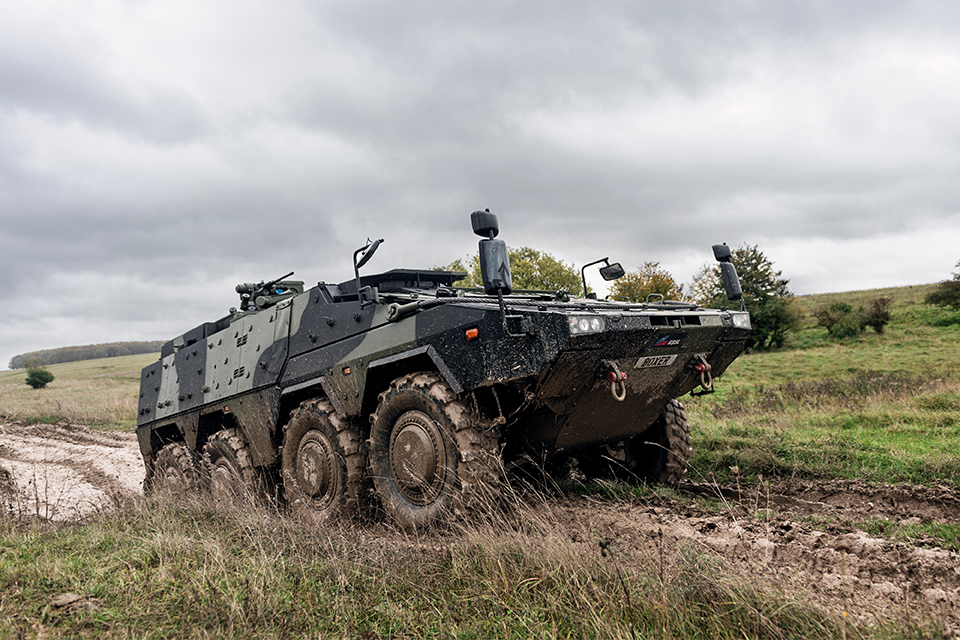
An eight-wheeled armoured Boxer vehicle
Armoured vehicles will benefit from increased protection against current and future threats giving operational advantage and greater survivability, thanks to technology advances by Dstl) and industry partners.
The Modular Integrated Protection System (MIPS) architecture supports the flexible teaming of a range of technologies to create a suite of Active Protection Systems (APS). The combination of sensors to detect the threats, and counter-measures to disrupt them, form a protective ‘bubble’ around the vehicle.
The MIPS architecture enables the development of best of breed APS capabilities, harmonising modular hardware and software components that can then provide protection across the current close combat vehicle fleet and future robotic and autonomous systems.
The work was developed through the Icarus Technology Demonstrator Programme, a collaborative industrial partnership led by Leonardo. By developing these implementations using common principles, support for future information interoperability across the digital battlespace is designed in from the start.
MIPS is also being applied to wider survivability and lethality functions such as countering uncrewed air systems (UAS) using the same core architecture, allowing a single survivability suite to provide a growing range of capabilities.
Rapid battle trench innovation
The Army requires its field infrastructure to be affordable and rapidly deployable with minimal logistical burden, while effectively protecting dismounted personnel and assets against a range of threats across all operating environments.
Working in conjunction with DASA and 2 non-traditional defence suppliers, Beardsell and Sons and Quickblock, Dstl is developing deployable infrastructure using innovative new materials and techniques.
A 4-person soldier battle trench consisting of a modular box frame and geotextile faces, and a rapid vehicle check point utilising modular, foldable building blocks, have been developed and successfully demonstrated.
User trials presented a major learning opportunity for the 2 suppliers with troops from Royal Engineers Trials and Development Unit deploying, operating from and then recovering the structures before providing feedback.
Blast trials were undertaken to understand performance of the 2 structures against representative threats, including 155mm artillery shell. The systems are being refined based on user feedback ahead of progressing to a technology demonstrator programme.
Armour expertise protects Challenge 3
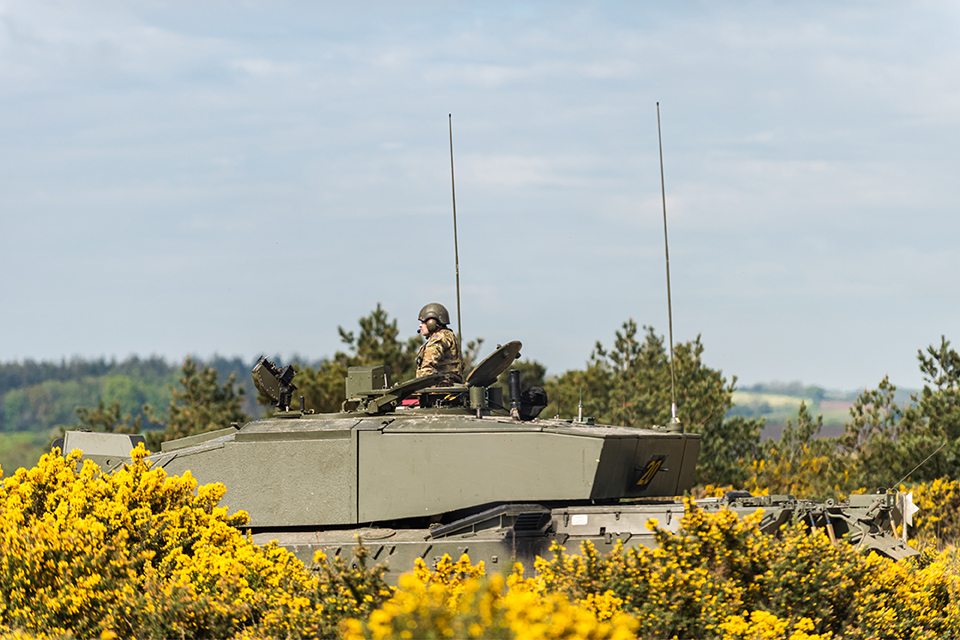
A soldier in a tank
Evidence from Dstl operational research underpinned key procurement decisions of the Challenger 3 Main Battle Tank (CR3), which is in production to be the most lethal tank in Europe.
While future engagements with adversaries may be conducted at greater distance than currently, CR3 will provide the ability to fight and win the close battle.
Dstl informed lethality, mobility and capability options on CR3 which is protected with world-leading new modular armour developed through advances in armour technology provided by the MOD Chief Scientific Adviser (CSA) funded armour expertise held within Dstl. This Dstl-owned intellectual property is being exploited through the close links between Dstl, MOD and industry.
Dstl has also developed Veles, a Crown-owned generic camouflage generator tool. Veles produces the optimum pattern for an environment in a few hours and can theoretically test an unlimited number of patterns, all of which are original.
Ultimately, this means that the Army can be much more reactive to the situations they are in, significantly improving signature protection for their people and platforms.
Greater power for future soldier
Connecting the Future Soldier - YouTube
Future soldiers will use multiple sensors and effectors to improve capability and situational awareness at the tactical level.
To achieve full benefit these capabilities must be able to share information both within the individual soldier system and beyond via secure communication links. In addition there is a need to reduce the battery burden and simplify logistics by powering such devices from a common battery rather than the multiple different types of batteries often carried by a dismounted patrol.
Dstl and its industry partners have prepared 2 future concepts for the next generation of soldier architecture. The first was built to current generic soldier architecture and includes embedded power monitoring to allow the scale of the future power problem to be understood. The second was a research demonstrator that explored concepts for greater power transmission, higher data rates and a range of on-body wireless technologies to allow the removal of troublesome cables in some instances.
Ultimately, fully integrated systems will unleash the power of combination allowing a soldier system to achieve more than the sum of its parts.
Air
Dstl Air Showcase Air Vice-Marshal highlights Dstl’s unique contribution to air defence - YouTube
Eyes in the sky

An artistic impression of a RAF Wedgetail aircraft flying over a coastline
Dstl is providing critical science and technology support to the acquisition of the E-7 Wedgetail Airborne Early Warning and Control aircraft, and to the P-8A Poseidon Maritime Patrol Aircraft Programme as it approaches full operational capability.
Both aircraft represent a step-change in UK intelligence, surveillance and reconnaissance capability, with Dstl delivering the operational analysis and decision support that informed the selection of both aircraft.
Our advice has drawn on deep expertise from across Dstl, from acoustics for P-8A sonobuoy systems, to radar knowledge for characterising E-7’s electronically scanned array, to human factors know-how, allowing us to assess likely workload of the operators on-board the aircraft. Established mechanisms for international collaboration allowed us to reach out to allies who operate Poseidon and Wedegetail, and gain from the experience of equivalent organisations (principally in Australia and the US) on data, analysis techniques and modelling relevant to the platforms.
Dstl operational analysis and technical advice continues to be sought on the optimisation, evolution and upgrade of the platforms, meaning that science and technology input is set to remain a central feature of Poseidon and Wedgetail into the future.
Advancing Apache’s survivability
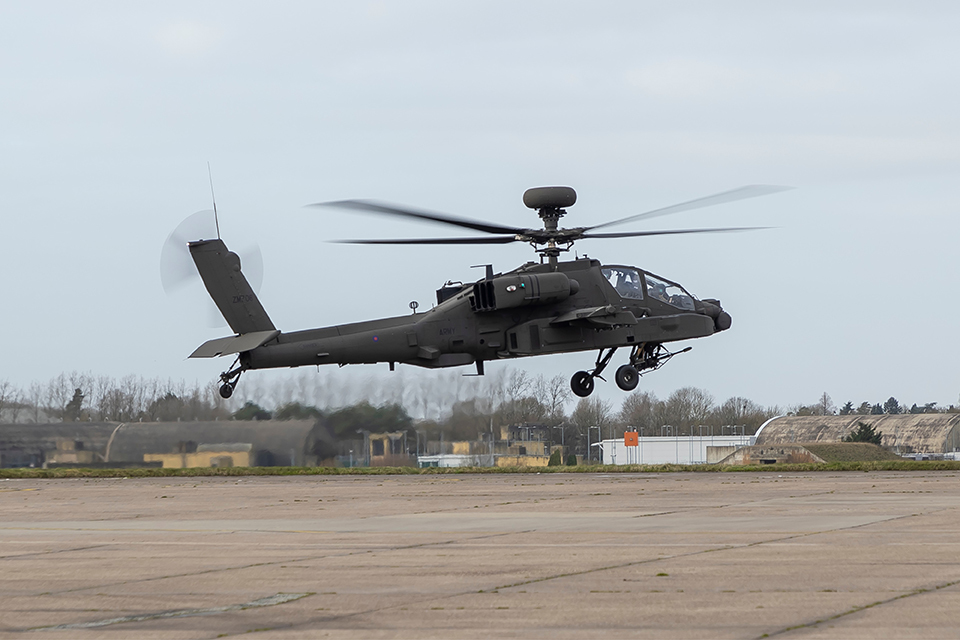
A black apache helicopter taking off
The Apache Mk 1 attack helicopter has been in service with the British Army for 22 years, proving to be an invaluable asset in support of operations in Afghanistan, Libya, and worldwide.
The latest Apaches, the AH-64Es, mark a leap in attack helicopter performance. Upgraded rotor blades and engines allow it to carry a heavier payload of weaponry with increased lethality. These weapons will have their targets acquired and guided by a vastly improved radar and sighting systems suite that will have the ability to integrate with uncrewed air systems (UAS).
The aircraft also includes an advanced target prioritising system which helps with rapid reassessment and survivability in countering enemy threats. Dstl’s evaluation of the safety of the AH-64E’s software and human-machine interface contributed to the aircraft’s release-to-service in 2022.
Dstl’s assessment of AH-64E’s defensive aids will contribute to the aircraft’s acceptance into service and will help ensure alignment with the Next Generation Air Survivability Programme. Finally, Dstl is helping inform AH-64E spiral development decisions to assure the aircraft’s future capability.
Countering uncrewed air systems (C-UAS)
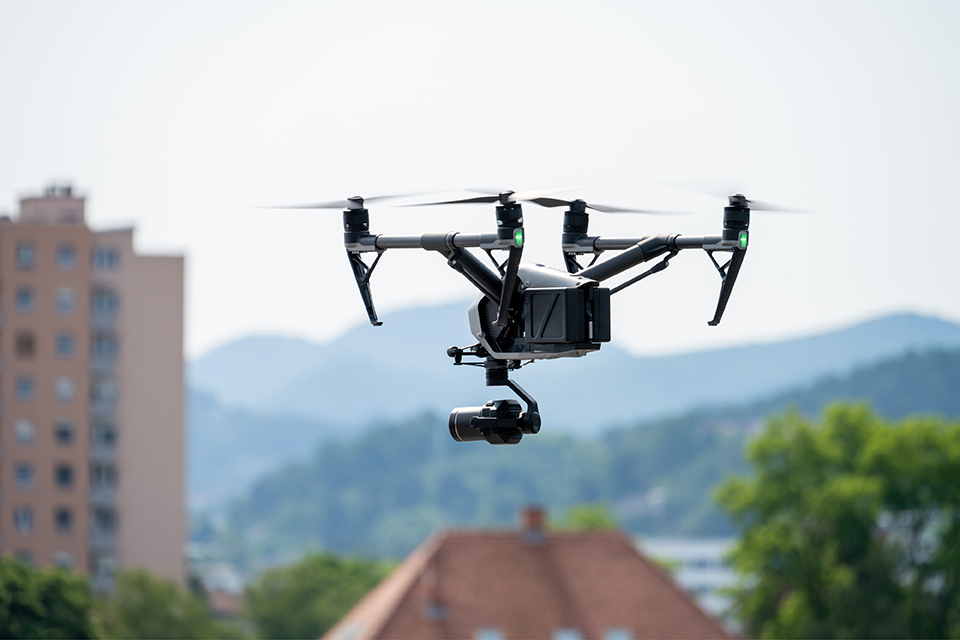
A drone flying over a town
The introduction of UAS represents a paradigm shift in military capability in many different states and agencies. This capability is evolving rapidly and the threat to UK and allied interests from the hostile use of these systems is growing exponentially.
We need to understand next generation and generation after next threats, each of which may require a different mitigation approach. Dstl supports MOD and civilian authorities to ensure that they have access to a range of viable capabilities to detect, track, identify and defeat hostile UAS across a range of situations and scenarios, and that stakeholders have access to impartial, evidence-based advice to support their decisions.
The Dstl C-UAS team coordinates the deep expertise of many different specialists in a broad range of analysis, technical and operational specialisations across the laboratory and in industry and academia both at home and abroad. We consistently maintain the golden thread from the stakeholder requirement through research and development to delivery.
Future combat air systems
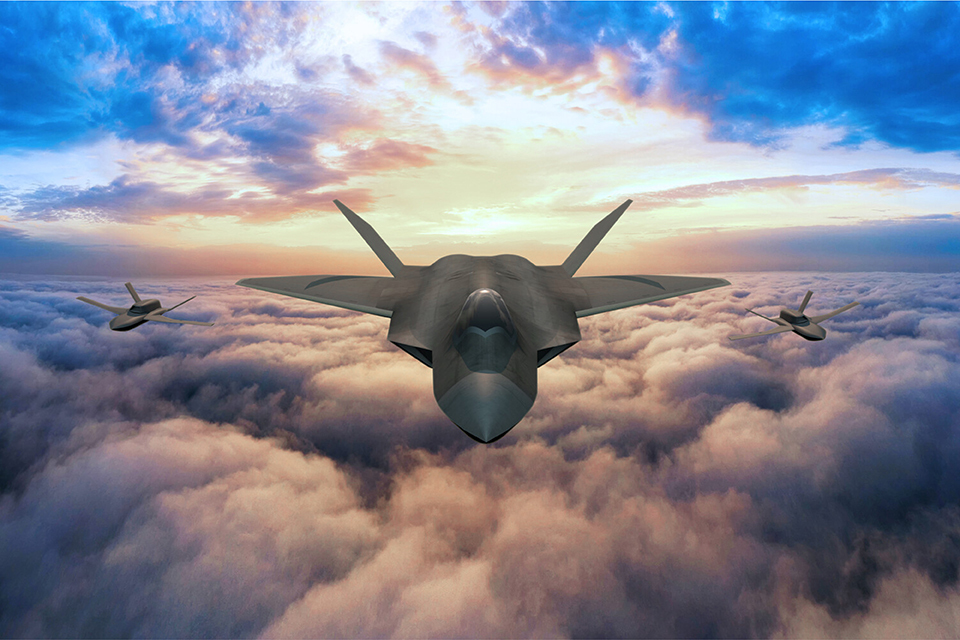
An artist impression of the Tempest future fighter jet flying
Dstl continues to expand the level of support it provides to the UK Future Combat Air Systems (FCAS) Programme, which is seeking to develop a next generation combat air system to replace Typhoon from 2035, with strategic implications for military capability, UK prosperity, and international influence.
Dstl staff are working in close partnership with stakeholders across MOD, RAF, UK industry, and increasingly with international partners, to shape FCAS direction and technical content.
Dstl’s support to FCAS covers almost every technical aspect of developing and procuring an advanced combat air system, including: operational analysis; air system concept design; flight demonstrations; software and mission systems; propulsion and power systems; weapons integration; and human-machine interface.
Protecting air platforms
The advent of increasingly capable Integrated Air Defence Systems and the spread of advanced weapons to less technologically advanced countries and non-state actors is expected to threaten the UK’s operational independence.
Dstl is at the heart of the innovative Next Generation Air Survivability (NGAS) approach which through Team PELLONIA, with strategic partners Leonardo, Thales and Chemring Countermeasures, will provide aircraft with advanced survivability solutions to counter emerging and future weapon systems and thus maintain the UK’s freedom of access and manoeuvre (FOAM).
Over the next decade, £100 million of RAF funding will be aligned with MOD science and technology research to develop, deliver, test, assure and spirally upgrade the NGAS elements to ensure advanced system-level solutions and functionality keeps pace with threat developments.
Air Platform Protection will be progressively rolled out to current and future fixed-wing and rotary-wing aircraft, with the potential to also adapt solutions for use on UAS. The first platforms being equipped with NGAS capabilities are Shadow Mk2 and E-7 surveillance aircraft, and the enterprise will sustain highly skilled jobs across the supply chain.
Security and policing
Explosive experts support counter-terrorism investigations

Two scientists in a forensic laboratory
Dstl scientists deployed to Liverpool at short notice to support the investigation into the explosion outside Liverpool Women’s Hospital in November 2021.
Our experts from the Forensic Explosives Laboratory (FEL) assisted police with the examination of the bomb scene and suspected ‘bomb factory’. Following this, they conducted detailed analysis to establish how the Improvised Explosive Device was constructed.
The FEL is funded by the Home Office to support the UK criminal justice system. FEL provides specialist forensic science to support investigations into the misuse of explosives by terrorists and other criminals across the UK mainland.
FEL’s remit includes providing scientific analysis within their dedicated laboratories, attending scenes to provide advice to first responders, and extends through to providing expert testimony to the courts.
Simulating explosions increases value for money

A simulated image of the impact of an explosion in a street
The ability of numerical models to predict the consequences of explosions has been improved significantly.
World-class specialist experimentation capabilities in UK industrial and academic partners are providing fundamental characterisation data on explosive propagation and blast. This data is being used to help develop cutting-edge synthetic environments which harness increased computing power and reduce the need for large-scale explosive trials.
This important progress has enabled us to predict accurately the performance of new systems for mitigating the effects of explosions in a range of priority security and defence scenarios, for a fraction of the cost and time of the equivalent large-scale explosive trials.
Novel cloned number plate detection
Dstl is exploring methods to improve police forces’ ability to detect cloned number plates on behalf of the Home Office and National Police Chiefs’ Council.
One of these methods consists of a novel machine learning algorithm developed by Dstl. The overall aim is to test these methods on national data in order to gain an understanding of the true scale of the problem of cloned plates.
Number plate cloning involves copying the identity of another vehicle by duplicating the number plate and most often attaching it to a vehicle of the same make, model and colour.
Cloned number plates are illegal and are becoming increasingly common but are incredibly difficult to identify. Cloned vehicles are often used to avoid speeding or parking fines, paying tax or insurance, or for more serious criminal acts such as organised crime.
Clean sweep for Commonwealth Games

A mechanical bull at the opening of the Commonwealth Games in Birmingham 2022
In advance of the 2022 Commonwealth Games in Birmingham, Dstl supported the military high-assurance search of particularly sensitive areas.
Dstl’s Explosive Detection and Identification team provided technical assurance and subject matter expertise for the military in-service explosives trace detection capability.
The team’s successful support of this search helped to safeguard the 1.3 million people who attended, including Royalty and Commonwealth representatives.
Dstl provides ongoing scientific and technical support to high-assurance searches nationwide, ensuring the UK and its citizens are protected.
National security collaboration
Co-creation is a new approach by the government science and technology community to collaborate with industry and academia by sharing challenges before potential solutions have been identified.
Established by NSTIx (the National Security Technology and Innovation eXchange), Co-creation enables those solving the problem to collaborate and continuously engage with the people who will use the solution.
The Operational Technology (Op Tech) Co-Creation Space is a joint programme between HM Government Communications Centre and Dstl with a focus on sensors, sensing and detection, RF systems and antennas, smart materials and power sources. The programme is in year 2 of 4, and is scaling up by taking on more challenges that prove, verify and challenge our ambitious operating model, whilst delivering impactful responses to challenges that customers can really take forward.
Novel commercial engagement approaches are needed to reach a far wider range of external partners, deliberately targeting non-traditional defence and security suppliers.
Dstl crime and policing programme.
Wider defence
Live agent training
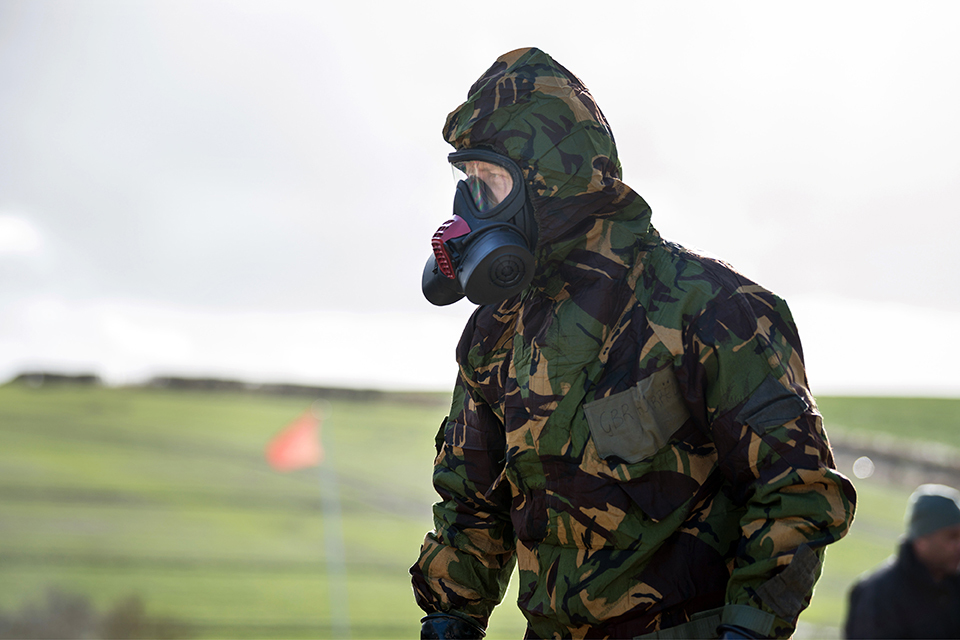
A scientist in camouflaged protective clothing
CBRN specialists are required actively to seek out, identify and deal with chemical, biological and radiological hazards.
While the majority of training for CBRN specialists is carried out using simulants and on exercises, this is supplemented with live CBR materials in order to gain experience in a controlled environment to fully prepare for operational roles.
Live agent training (LAT) includes a range of traditional chemical warfare agents, biological toxins, biological warfare agent surrogates, and sealed and unsealed radiological sources.
The units are able to practice with their in-service detection, identification, monitoring (DIM) and safety equipment during the training in order to develop confidence, maintain their own effectiveness and to preserve the capability of their units in this very important area.
Specialists usually first attend a basic course at Dstl focusing on individual skills before returning to conduct more advanced, role specific training. Dstl delivers 10 LAT events annually, advises on policy and safety, and also ensures that training conducted by UK troops overseas meets the same high standards as that delivered in the UK.
Future of explosives expertise

An apprentice in a workshop
Dstl hosts a wide range of capabilities in energetic material technologies spanning; synthesis and manufacturing, detection, characterisation, forensic analysis, breakdown and render-safe of explosives and energetic devices.
This expertise is essential and underpins both UK defence and homeland security. MOD has invested millions of pounds into research and development through Dstl to ensure we retain this critical sovereign capability. This includes investment in people, with graduates and apprentices working alongside experienced staff, as well as next generation energetics technologies such as 3D printing of explosives, resonance acoustic mixing (RAM) and novel diagnostic methods.
This work directly impacts how the UK responds to threats, whilst rapidly building up skills in people to meet future requirements.
Dstl is also funding early stage research aimed at using automated, innovative and emerging technologies to both accelerate the discovery of new energetic materials and to identify alternative synthesis routes to novel and existing explosives to deliver generation after next capabilities.
The team is working collaboratively with industry and academia to invest in a range of multidisciplinary technologies including synthetic biology, flow chemistry, robotics, machine learning and computational chemistry.
Shaping defence decision making
We provide impartial and robust evidence, across defence, to support decisions by senior MOD officials and operational commanders about policy, planning, operational and support issues.
Between 2017 and 2022 analysts delivered a range of policy options, costed whole force structure designs, evaluated and compared their efficacy, and led department leadership through balance of investment to enable them to weigh up courses of action.
The programme’s input directly shaped the department’s 2019 spending round uplift of £2.2 billion for 2 years and the contents of the 2020 to 2021 4-year settlement of £16.5 billion delivered with the Integrated Review.
Working with NSC/QinetiQ Dstl has developed Lance, a new campaign-level joint warfighting model that enables analysts to assess the effectiveness of force structures within scenarios. It simulates the multi-domain interactions between air, land, maritime, space and joint force elements; and will expand to represent cyber and information effects.
Lance simulates warfare to discover what it takes to win to help defence assess the effectiveness of force structures within scenarios - including a force’s ability to achieve specific military objectives, the time taken, losses of assets, casualties and other costs such as fuel and munitions consumed.
Tackling climate change
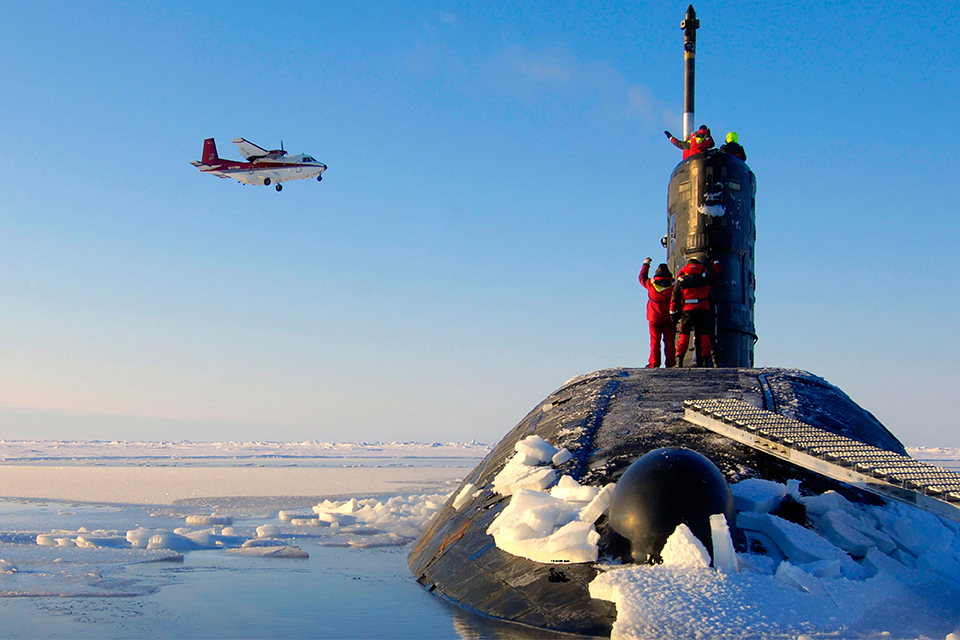
A submarine breaking through ice
The impact of climate change poses both challenges and opportunities for defence and security.
Science and technology is integral to futureproofing defence’s ability to outpace, outlast and outrange its adversaries within a climate changed world. Through established and innovative research Dstl has created a new Support and Sustainability Programme to help the armed forces exploit cutting-edge technologies that create advantage for defence and wider government.
These include integrating a range of technologies across logistics and support, climate change and sustainability, and power and energy. The MOD-funded programme will deliver science and technology solutions to help defence adapt and become resilient to a climate-changed world, seizing opportunities to achieve operational advantage through embedding sustainability into military capability, working closely with UK Strategic Command, Defence Support, and MOD Head Office Climate Change and Sustainability Directorate.
The new programme will support Dstl’s own sustainability committee, which implements the organisation’s strategic direction, provides senior leadership support and governance, and widens the understanding of sustainability across Dstl.
The programme will also assist the UK’s first critical minerals strategy that aims to improve the security of supply of critical minerals, specifically in the future operating environment for defence and in the context of Net Zero and decarbonisation of the UK economy.
By 2040 it is expected the world will need 4 times as many critical minerals for clean energy technologies than it does today.
Find out more about Dstl and follow us on Twitter, LinkedIn, and YouTube for the latest information about our work.

